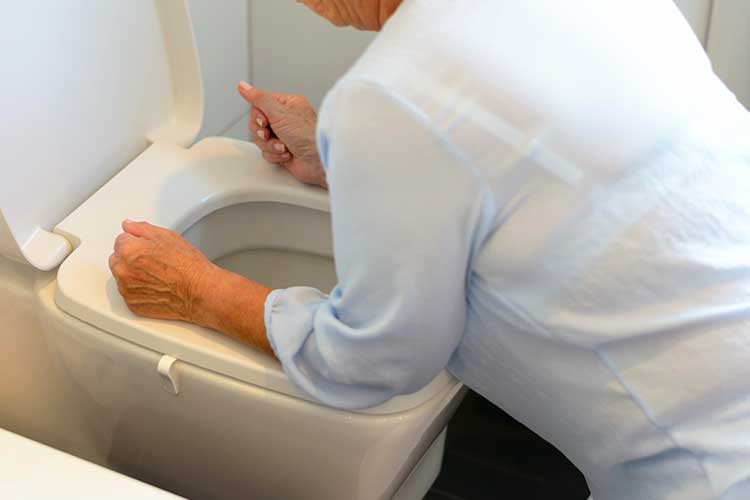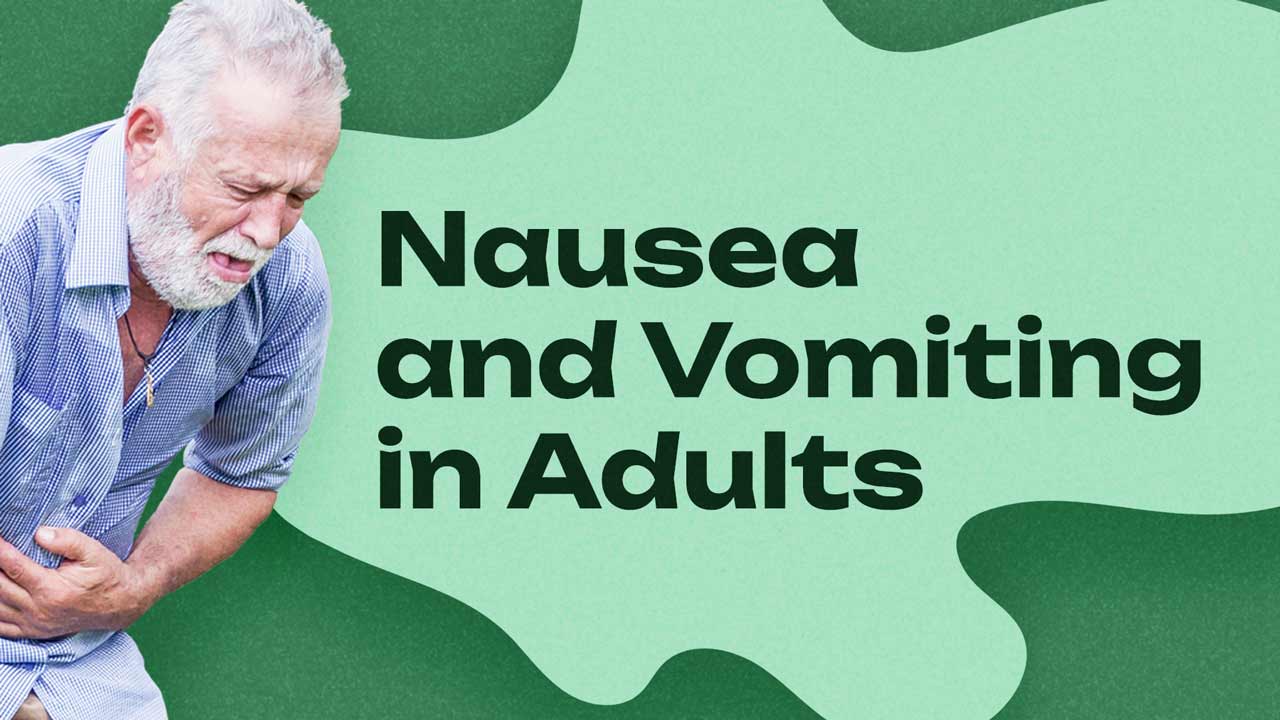Nausea and vomiting are common symptoms that are associated with a variety of conditions (Mayo Clinic 2023).
What are Nausea and Vomiting?
It is important to note that nausea and vomiting are not conditions themselves - rather, they are non-specific symptoms (Cleveland Clinic 2023).
- Nausea describes a feeling of unease in the stomach, chest or throat. Someone experiencing nausea will usually feel the urge to vomit, but vomiting will not necessarily occur.
- Vomiting (emesis) is the physical act of forcibly ejecting stomach contents through the mouth. This may be a voluntary or involuntary action. Vomiting may occur independently of nausea.
(Cleveland Clinic 2023; Parrott-Sheffer 2025; Wedro 2023)
Vomiting is a protective mechanism used to expel harmful substances in the stomach. It may also occur in response to irritation in the gut (NHS Inform 2023).
While nausea and vomiting may indicate a serious condition, they are not usually a cause for concern and generally resolve after one to two days (NHS Inform 2023).
Symptoms that are often associated with nausea and vomiting include:
- Abdominal pain
- Diarrhoea
- Headache
- Fever
- Gas
- Dizziness
- Lightheadedness.
(Wedro 2023)
Acute nausea and vomiting generally describes symptoms that resolve within 48 hours. Nausea and vomiting that persists for over 48 hours may lead to complications or indicate a more serious illness (McKechnie 2024).

The Physiology of Vomiting
There are several sites involved in nausea and vomiting, in particular:
- The chemoreceptor trigger zone (CTZ) , which is located in the brain near the vomiting centre in the medulla
- The gastrointestinal tract
- The vestibular system, which is responsible for balance, spatial orientation and movement
- The higher centres in the cortex and thalamus.
(Athavale et al. 2020; MacDougall & Sharma 2023)
These sites relay information to the vomiting centre, which is located in the medulla oblongata (part of the brain stem) and receives input from the nucleus tractus solitarius and vagus nerve. The vomiting centre is in charge of causing the vomiting reflex (MacDougall & Sharma 2023; Athavale et al. 2020).
There are specific neurotransmitters that induce the action of vomiting. These include histamine, dopamine, serotonin, acetylcholine and neurokinin (Athavale et al. 2020).
Prior to vomiting, the individual may experience:
- Nausea
- Sweating
- Increased heart rate
- Increased saliva production.
(Healthdirect 2024a; Mandal 2023)
During the vomiting process, muscles in the diaphragm, chest wall and abdomen begin to contract, forcing the stomach contents upward. While this occurs, the epiglottis closes to ensure that the stomach contents cannot enter the trachea or lungs (Yartsev 2022; Anatomy.co.uk 2025).
Causes of Nausea and Vomiting
There are many potential causes of nausea and vomiting, including:
- Gastroenteritis
- Migraine
- Intense pain
- Motion sickness
- Certain medicines (e.g. nonsteroidal anti-inflammatories, oral contraceptives, narcotics, antibiotics)
- Alcohol
- Stress
- Bowel obstruction
- Cancer treatments (e.g. chemotherapy)
- Gallbladder inflammation
- Viral or bacterial infections
- Food poisoning
- Pregnancy
- General anaesthesia
- Appendicitis
- Dizziness
- Vertigo
- Ear infection
- Fever
- Heart attack
- Anxiety disorders
- Irritable bowel syndrome
- Allergies and anaphylaxis
- Labyrinthitis
- Certain cancers
- Changes to water and food while travelling
- Hyperglycaemia
- Hypoglycaemia
- Hypovolaemia
- Hypotension
- Kidney infection
- Kidney stones.
(Healthdirect 2023a, 2024b; Mayo Clinic 2023)
Please note that this is not an exhaustive list of all potential causes.
Complications of Nausea and Vomiting
Rarely, nausea and vomiting may indicate a serious underlying condition such as appendicitis, meningitis, concussion or a brain tumour (Cleveland Clinic 2023).
If a client has had a fall or injury to the head, escalate care and call an ambulance.
Seek emergency medical attention if a client is experiencing any of the following symptoms in addition to vomiting:
- Vomiting that persists for more than 48 hours
- Green vomit (indicating the presence of bile)
- Severe chest pain
- Severe abdominal pain or cramps
- Confusion
- Stiff neck accompanied by a high fever
- Faeces present in vomit
- Rectal bleeding
- Blood present in vomit (resembling coffee granules)
- Sudden, severe headache
- Signs of dehydration
- Inability to keep water down or drink more than a few sips of liquid
- Person is immunocompromised
- Suspected poisoning.
(Healthdirect 2024a; NHS Inform 2023; Cleveland Clinic 2023)
Persistent Nausea and Vomiting

Persistent nausea may be highly distressing and cause feelings of exhaustion or depression (McKechnie 2024).
Persistent vomiting may lead to issues such as:
- Dehydration
- Electrolyte imbalance
- Damage to tooth enamel due to erosion from stomach acid
- Bleeding caused by tears to the oesophageal lining
- Weight loss.
(McKechnie 2024; Healthdirect 2024a)
Symptoms that indicate dehydration include:
- Reduced urine output
- Dark urine
- Sunken eyes
- Dry mouth and tongue
- Fatigue
- Headache
- Confusion or a change in cognition
- Rapid heartbeat
- Low blood pressure
- Muscle weakness.
(NHS Inform 2023; VIC DoH 2023)
Managing Nausea and Vomiting
Start Course: Nausea and Vomiting Treatment Options
If a client is experiencing nausea or vomiting:
- Consider administering medicines such as antacids or antiemetics
- Provide clear fluids such as water or herbal tea and ensure the client takes frequent small sips to prevent dehydration
- Consider giving oral rehydration fluids
- Avoid giving caffeinated beverages such as coffee or soft drinks
- Encourage the client to nibble on light, bland foods that are easily digestible (e.g. dry crackers, rice, plain bread)
- Encourage the client to sit down or lie with their head elevated
- Discourage brushing teeth immediately after a vomiting episode, as this may cause stomach acid to erode the tooth enamel
- Encourage rest
- Avoid providing solid foods until the vomiting has stopped.
(Healthdirect 2023a, b, 2024a; LeWine 2023; NHS Inform 2023; Cleveland Clinic 2023)
Preventing Nausea and Vomiting

The best way to prevent nausea and vomiting is to maintain effective hygiene practices, as this will reduce the risk of spreading infections that cause these symptoms (Healthdirect 2024a).
Refer to the following articles for comprehensive information on maintaining effective hygiene:
- Hand Hygiene 101
- Donning and Doffing PPE Correctly
- Effective Surface and Environment Cleaning
- Food Handling Basics
- Infectious Diseases: How Do You Break the Chain?
- Infection Prevention in the Home
- Healthcare Waste: Collection, Storage and Disposal
Strategies for preventing nausea and vomiting that are unrelated to infection include:
- If possible, avoid exposing clients to nausea triggers such as strong smells or certain foods
- Encourage clients to eat small meals regularly and avoid complete stomach emptying
- Avoid providing foods that are difficult to digest
- Serve foods at room temperature to clients who are nauseated by the smell of hot foods
- Ensure clients consume adequate water throughout the day
- Encourage clients to rest with their head elevated after eating
- Encourage clients to eat and drink at separate times
- Discourage clients from standing up or getting out of bed suddenly
- Take precautions for motion sickness if it is expected.
(Healthdirect 2023a; Cleveland Clinic 2023)
Test Your Knowledge
Question 1 of 3
Which one of the following best describes the relationship between nausea and vomiting?
Topics
Further your knowledge
 Free
Free Free
Free Free
Free Free
FreeReferences
- Anatomy.co.uk 2025, Epiglottis, Anatomy.co.uk 2025, viewed 8 April 2025, https://anatomy.co.uk/epiglottis/
- Athavale, A, Athavale, T & Roberts, D M 2020, ‘Antiemetic Drugs: What to Prescribe and When’, Australian Prescriber, vol. 43, no. 2, viewed 7 April 2025, https://www.nps.org.au/assets/p49-Athavale-et-al.pdf
- Cleveland Clinic 2023, Nausea & Vomiting, Cleveland Clinic, viewed 7 April 2025, https://my.clevelandclinic.org/health/symptoms/8106-nausea--vomiting
- Parrott-Sheffer, C 2025, Vomiting, Britannica, viewed 7 April 2025, https://www.britannica.com/science/vomiting
- Healthdirect 2023a, Nausea, Australian Government, viewed 8 April 2025, https://www.healthdirect.gov.au/nausea
- Healthdirect 2023b, Dental Erosion, Australian Government, viewed 8 April 2025, https://www.healthdirect.gov.au/dental-erosion
- Healthdirect 2024a, Vomiting, Australian Government, viewed 8 April 2025, https://www.healthdirect.gov.au/vomiting
- Healthdirect 2024b, Underlying Causes of Vomiting, Australian Government, viewed 8 April 2025, https://www.healthdirect.gov.au/what-causes-vomiting
- LeWine, H 2023, Nausea, Harvard Health Publishing, viewed 8 April 2025, https://www.health.harvard.edu/a_to_z/nausea-a-to-z
- MacDougall, M & Sharma, S 2023, ‘Physiology, Chemoreceptor Trigger Zone’, StatPearls, viewed 7 April 2025, https://www.statpearls.com/ArticleLibrary/viewarticle/19371
- Mandal, A 2023, Vomiting Mechanism, News-Medical.Net, viewed 8 April 2025, https://www.news-medical.net/health/Vomiting-Mechanism.aspx
- McKechnie 2024, ausea and Vomiting, Patient, viewed 7 April 2025, https://patient.info/digestive-health/nausea-and-vomiting
- Mayo Clinic 2023, Nausea and Vomiting, Mayo Clinic, viewed 7 April 2025, https://www.mayoclinic.org/symptoms/nausea/basics/definition/sym-20050736
- NHS Inform 2023, Vomiting in Adults, NHS Scotland, viewed 7 April 2025, https://www.nhsinform.scot/illnesses-and-conditions/stomach-liver-and-gastrointestinal-tract/vomiting-in-adults
- Wedro, B 2023, Nausea and Vomiting, MedicineNet, viewed 7 April 2025, https://www.medicinenet.com/nausea_and_vomiting/article.htm
- Victoria Department of Health 2023, Dehydration: Standardised Care Process, Victoria State Government, viewed 8 April 2025, https://www.health.vic.gov.au/residential-aged-care/standardised-care-processes
- Yartsev, A 2022, Nausea and Vomiting, Deranged Physiology, viewed 8 April 2025, https://derangedphysiology.com/main/cicm-primary-exam/gastrointestinal-system/Chapter-131/nausea-and-vomiting
 New
New 
